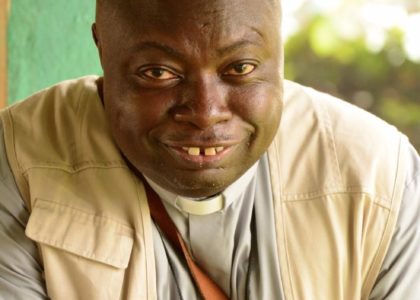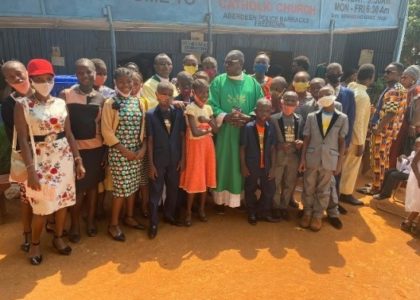 September 2020
September 2020
By Megan Smith
When I discuss Sierra Leone, I find most people have never heard of the small West African country. I’ll mention “Blood Diamonds” the very famous movie in the 90’s, starring Leonardo DiCaprio, or child soldiers and the country’s ten year long civil war. It is those mentions that spark a bit of knowledge. But still, most are unfamiliar. And there’s so much more to Sierra Leone, so much to love about this country, its people and its varied terrain. Bordered by the Atlantic Ocean, there are beautiful, white sand beaches backdropped by mountains, several islands, coastal waters, estuaries and rivers, lush terrain, tropical rainforests and deep forest surroundings. “The original Portuguese name, Serra Lyoa (“Lion Mountains”), referred to the range of hills that surrounds the harbor. The capital, Freetown, commands one of the world’s largest natural harbors.”
I’ve been fortunate enough to visit Sierra Leone a handful of times and while our days and nights are occupied with of course, work, we try to see something new each trip. If time allows, we explore the unknown in beautiful Salone. Reading about the country I came upon Bunce Island. I was ignorant of its history and wanted to learn more. We asked our Sierra Leonean friends and coworkers about the island. Very little was known. They knew it was there of course, its history of slavery, but none had visited.
Mind you, it’s not the easiest island to explore. You must rent a boat which takes about 45-minutes to reach the shores. You are limited on time because of the rising tides and access to the island. And it’s not cheap for those in Sierra Leone to visit. Sixty percent of the population live below the national poverty line, thus remaining one of the world’s poorest nations. Although many Sierra Leoneans express the longing to visit this historically significant site, it’s just not feasible.
Bunce Island – Link to North America

I had no idea the island accounted for one of the largest European slave trading sites. Fifty thousand or more men, women and children ripped from their homes, held captive and forced into slavery on boats set sail for America. Most of the slaves who went through Bunce Island from what they called the “African Rice Coast” were sent to South Carolina, Georgia, and Florida where knowledge of rice cultivation was in high demand. African farmers with rice growing skills were kidnapped from the inland and sold at Bunce Castle. Bunce Island has been called “the most important historic site in Africa for the United States”.
And it truly is, but sadly the history is nonexistent in schools. I would never know of this island if not for our work in Sierra Leone. The Yale MacMillian Center notes, “Bunce Island is so strongly linked to North America, though, that its connections go well beyond South Carolina, Georgia, and Florida. Recent historical research has shown that slave ships based in Rhode Island, Connecticut, and Massachusetts stopped at Bunce Island regularly in the 1750s and 1760s. New England slave merchants sailed the human cargoes they purchased at Bunce Island to Charleston and to various ports in the West Indies.”
Situated in Freetown Harbor, the estuary of the Rokel River and Port Loko Creek, about 20 miles upriver from Sierra Leone’s capital city Freetown is Bunce Island. The British slave trading castle worked strategically for European slave traders because of its location, allowing easy navigation for oceangoing ships in Africa’s largest natural harbor. In 1670, the island was fortified by English slave traders and operated until 1808.
The quiet ride to Bunce Island
The day planned for our visit was met with rains in the early morning hours. A boat was reserved and about 15 Sierra Leoneans, coworkers and friends of the foundation were set to come along. We thought we would have to cancel the trip, and everyone was disappointed. But luck was on our side because the sun started to pierce through the clouds, the rain subsided, and we had just enough time to make it to the boat dock and jump onboard to visit this historic site. This was altogether a different kind of tourist site to take in. Aware of its history, I believe the whole group shared the same anticipation that was met with reflection and sadness. It was a quiet boat ride to the island, a respectful attribution for those that suffered at this site.

As we neared, I was surprised at how small the island was. It is surrounded by dense forest and has a small sandy beach that runs along its outskirts. The rocky waters began to settle as the boat pulled up to the islands edge and there was an eerie stillness in the air. As our group unloaded from the boat, the island’s tour guide and resident caretaker greeted us. He has been a staple to the island, providing maintenance and keeping a watchful eye over this important site.
Walking back in time

Rich vegetation fills the land with magnificent looking trees that look like something out of Narnia. Overgrown plants and shrubbery cover most of the island. Unique and beautiful flowers have made their homes in the trees, bushes and tall grass. We walked along winding trails to the varied sites. There is a calmness and tranquility on the island. It is hard to describe really, that feeling of walking back in time, through history where darkness prevailed, and thousands of innocent lives lost.
This was a tangible history lesson for us all and that kind of experience allows you to understand the true suffering and devastation of the past. One simply cannot grasp the brutalities that slaves endured. Thousands of men, women and children kidnapped, ripped from their homes, families divided never to be seen again, thousands killed. Innocent people treated as a commodity all for profit’s sake. I walked in the indentations of ghosts of the past and words just couldn’t suffice.
Somber History Lesson

Each step closer to the ruins on the island brought forth deep emotion, a feeling far exceeding empathy. Walking the paths and trails with my friends, fellow Sierra Leoneans, I witnessed the bereavement on their faces, saw the reflection of sorrow in their eyes, knowing family members could have been standing on this very site. Yet, like a Sierra Leonean person does, they smile stoically because while the past is important to remember and acknowledge, their resilience wants them to stand strong and keep moving forward. At times we separated and walked off alone standing at certain sites, lingering longer than others. Some stood in prayer, some stood in honor, but I think during those alone times we all stood in solidarity for the lives and loved ones lost to that island.
Canons still visible

Bunce Island House, the headquarters building where the Chief Agent lived with his senior officers, was at the center of the castle. Old canons with markings of the Royal Crest laid amongst the deep grasses on the island. The canons were placed along the islands edge to “protect” it from invaders. Gravesites, all dilapidated, show the names of British officers. We learned that any African who died on the island was not given a headstone, or any markings. It was as if they were trying to erase their existence, or maybe trying to erase their own brutality by ignoring the deceased.
We passed what appeared to be watch towers and holding cells. The tour guide showed us “the hole” similar to what they call “the hole” in prisons. Dug into the ground with very little light peering through, prisoners of the island who acted out were forced into this hole. They had no room to stand or stretch out. Some were held for days, weeks with little food or water. Many died in the hole, children included.

The buildings, or remnants of buildings have vegetation growing in and out of them from every direction. But considering the age and inclement weather the island endures, it’s pretty remarkable such structures still stand. I looked at these crumbling remnants, astonished at the fact that it was this vegetation keeping them alive. Massive tree roots intertwined and held together the fortress headquarters. The best way I can describe is like seeing someone use their back, arms and legs to lift something heavy. That was what these trees were doing. They were holding on, with all their might, to the remnants of this island. They were holding onto history. Nature has an incredible way of devastating homes and structures, yet here we are on this island that gets trounced with rains and winds and the roots just dug in and began lifting the past.
More need to visit Bunce Island

Some think the vegetation is swallowing the remains. I don’t agree. I’d like to think its nature’s way of not letting us forget. The trees hold up these structures for the thousands of innocent lives lost. The atrocities that occurred on Bunce Island will not be erased because buildings have crumbled and disappeared. Mother nature had its eyes on this island and now it’s the heart of what keeps its devastating past and truths alive. History books continue to ignore it, but it won’t be forgotten. It was a humbling visit, that provided great detail and history for not only Sierra Leoneans and Americans, but people all over the world.













